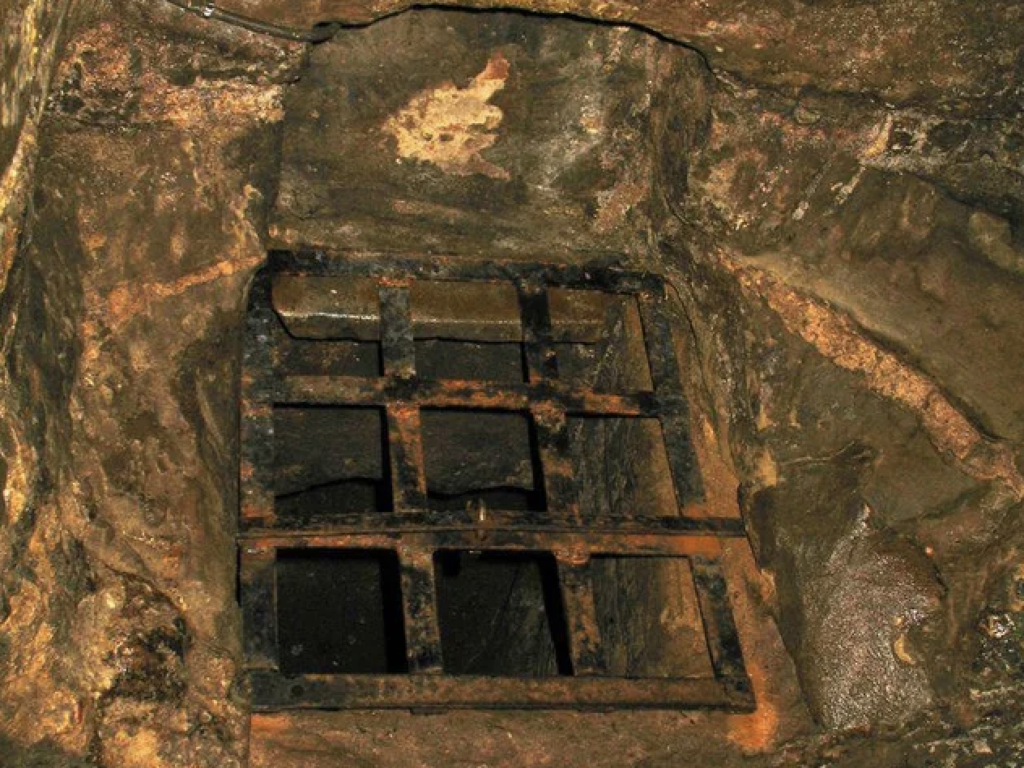The Middle Ages is known for many things: Vikings, the life and death of Mansa Musa, and tragedies like the great famine and the Black Death, which are just some of the fascinating aspects of the time.
One of the more discussed topics of the Middle Ages is the use of torture devices.


From the thumb screw (a pain-inflicting device designed to crush a person’s thumbs) to the iron maiden (an upright iron casket with spikes on the inside to pierce the victim), the medieval period was known to be brutal.
These methods would often be used as a way to punish those caught breaking the law or to exact a confession from a suspect.
For example, if someone were found guilty of treason, they would be burned at the stake.
In order to get someone to confess to such a crime, they’d be subjected to often scary methods of torture, such as “the rack,” which stretched an individual and tore their muscle fibers.
One of the lesser-discussed aspects of the Dark Ages is the use of oubliettes. These were medieval prisons utilized as a form of punishment, and in true medieval fashion, the prisoners endured untold suffering and agony.
Oubliettes were built in castles across Europe, and upon being discovered centuries later, many were found with the bones of the prisoners still trapped inside.
The Oubliette Dungeon
The word “oubliette” stems from the French word “oublier,” which translates as “to forget” or “to leave behind.”
The dungeon was named so because, more often than not, the person thrown inside was forgotten about, left to die of agonizing starvation and dehydration.
The oubliette itself was bottle-like, meaning once a prisoner was thrown in from the top, they had no chance of clambering out. The individual was hurled in from a trap door at the top with a lengthy, narrow descent to the bottom.
The prison itself allowed little room for maneuver. In fact, many of them were built so the person inside couldn’t sit, kneel, or do much else but stand and await their fate.
There was no source of light, meaning anyone tossed into an oubliette was confined in complete darkness for the duration of their nightmarish stay—which was often until their bodies gave up fighting the lack of sunlight, nutrients, and water.

Inside a cold, dark oubliette, there was nothing for a person to do but be with their own thoughts.
Depending on the crime or alleged infraction the prisoner had committed, they could be entirely forgotten about once in the dungeon. Others found they were tossed the bare minimum supplies to keep them alive.
However, this didn’t quell their suffering: they were being kept alive to stand in bleak darkness, accompanied by nothing but the rats who lived among them, waiting for them to die.
It was an awful existence for anyone unfortunate enough to find themselves in an oubliette.
Not only did the prisoners have to contend with the physical pain and deterioration they suffered, they were confronted with mental struggles, too.
Slowly, they’d often lose their sanity and sense of reality, their brain unable to adjust to the hell of persistent darkness and cold, damp claustrophobia. The trap door above them was often in view but painfully out of reach.
Some so-called “bottle-shaped prisons” were built deep into the ground, ensuring the inhabitants were as far from civilization as possible.
Others, however, were built at the top of the castle, encased inside the walls, offering an equally unpleasant experience for the prisoner.
The only difference is that those left underground could not hear the sounds of people and the noise of life going on above them.
Those held at the top of the castle were forced to endure the sounds of laughter and chatter of the free as they were trapped within the narrow, dank walls that encased them.
The prisoners who weren’t fed or eventually released were left to die. The agonizing death would take anything from a few days to upwards of ten days.
The prisoner would become delirious in their final hours, their bodies slowly shutting down, the pain so severe that death would likely have felt like the preferable option.
When one prisoner died, the guards wouldn’t remove or dispose of the corpse. The rats would eat it, and another prisoner would be thrown in with the decaying corpse.
Where Were Oubliettes Located?
The dungeons were built in or under castles all over Europe. From Ireland to Wales to Turkey, the oubliette’s design and purpose remained the same no matter where it was built.
One of the more well-known castles that incorporated oubliettes into its design was Leap Castle in Roscrea, Ireland. The castle was built by a renowned clan named the O’Carrolls, who sought power through violence and murder.

Naturally, when constructing their castle, they implemented the use of oubliettes.
The castle was primarily used as a safe house for the clan and to hide their valuables. However, it was also used to kill their enemies.
Wooden spikes lay on the floor of the oubliette, causing a horrible death for those thrown into the dungeon.
Those who died instantly were the lucky ones. Those who were impaled yet clung to life after being thrown in were forced to suffer a prolonged, agonizing death among the sharp spikes.
The castle left the O’Carroll family in the 17th century, and when the new family took over, they were shocked to find a heap of skeletons in the dungeon of death.
The bones and decaying bodies had to be removed by staff, who found themselves moving cart after cart of bodies out of the premises.
Due to the horrific way these people died—and the sheer amount of bodies recovered—it’s believed the castle is filled with the spirits of the deceased.
In Wales, Pembroke Castle and Conwy Castle have old oubliettes on the grounds, and France has Bastille prison, which notably made use of oubliettes as part of its design.
Warwick Castle is a famous UK castle that is known to have oubliettes, as has the Black Tower at the Roumeli Hissar in Turkey.
This was known to be especially cruel: captives would be marched along a long, dark passage, unable to see where they were going. Then, they’d suddenly drop through the trap door to the oubliette below, often suffering a fate worse than death.
Prisoners found themselves inside one of these terrifying dungeons because they’d done something that deemed them deserving of pain and torture.
The local and social landscape of the Middle Ages was not skewed towards fairness, meaning the oubliettes were often used to imprison political enemies or captured invaders.
There likely was a high number of innocent people who fell foul to the horrors of the oubliette, too. This was a time when people were killed for allegedly being witches and received brutal floggings (or worse) for being caught stealing food.
Death and the Dark Ages go hand in hand, and the oubliette is just one more method the people of this time used to punish those deemed criminal.
However, some sources believe oubliettes and their use has been dramatically exaggerated over time.
A Tale Of Fiction Or A Real Deadly Dungeon?
Oubliettes were built and certainly existed; however, the purpose of their creation has been questioned over the years.
Naturally, the thought of being thrown into one conjures feelings of terror and evokes feelings of empathy for those who died in such a brutal way.
However, many historians believe the use of oubliettes has been exaggerated and hyperbolized over the years. After all, the existence of oubliettes all across Europe makes for an engaging, sinister story.
But some don’t believe these horror stories are as accurate as they’re made out to be. It’s been uncovered that some castles with in-built oubliettes didn’t use them for killing.
Instead, the underground dungeons, in particular, were often used to store ice and perishables in a time before refrigeration. Some oubliettes have since been uncovered as a sewage system that merely looked like the typical bottle-like dungeon style.
If you retrace the history books, there’s very little talk of oubliettes. Considering they were allegedly much-used across Europe, there’s not a great deal of material on them or historical accounts of their usage.
Although some believe the use of these dungeons is nothing more than an exaggerated horror story, there is undeniable proof that they existed, often for the sole purpose of causing prisoners an agonizing death.
Over the years, many corpses and decaying bones have been found in the walls and dungeons of castles all over Europe. The argument isn’t if they existed at all, but rather how often they were used as a form of punishment.
Judging by the enormous piles of bodies found in some oubliettes, though, it can be hard not to believe the horror stories of the deadly dungeons.
Sources
https://owlcation.com/humanities/Oubliette-French-Torture-Halloween
https://www.exploring-castles.com/castle_designs/castle_dungeon












Leave a comment